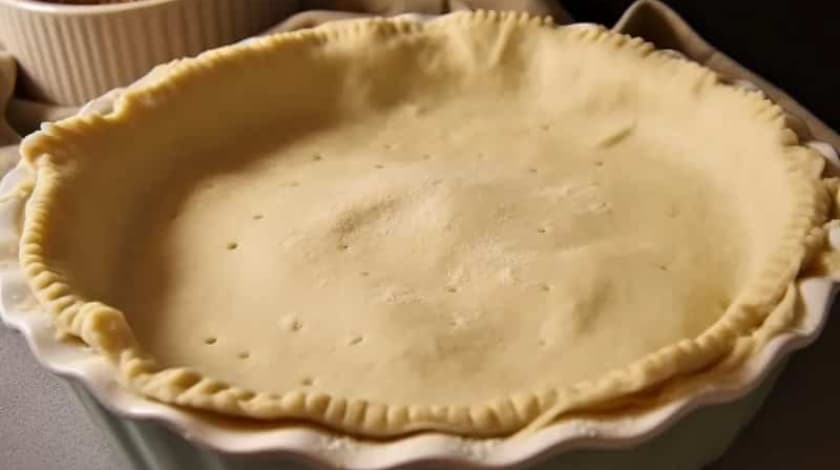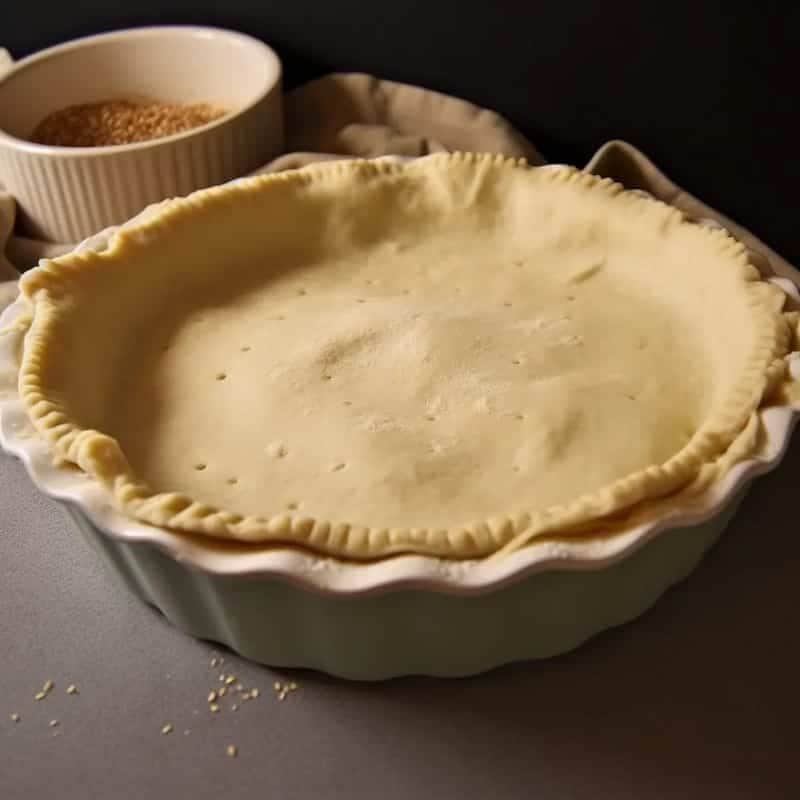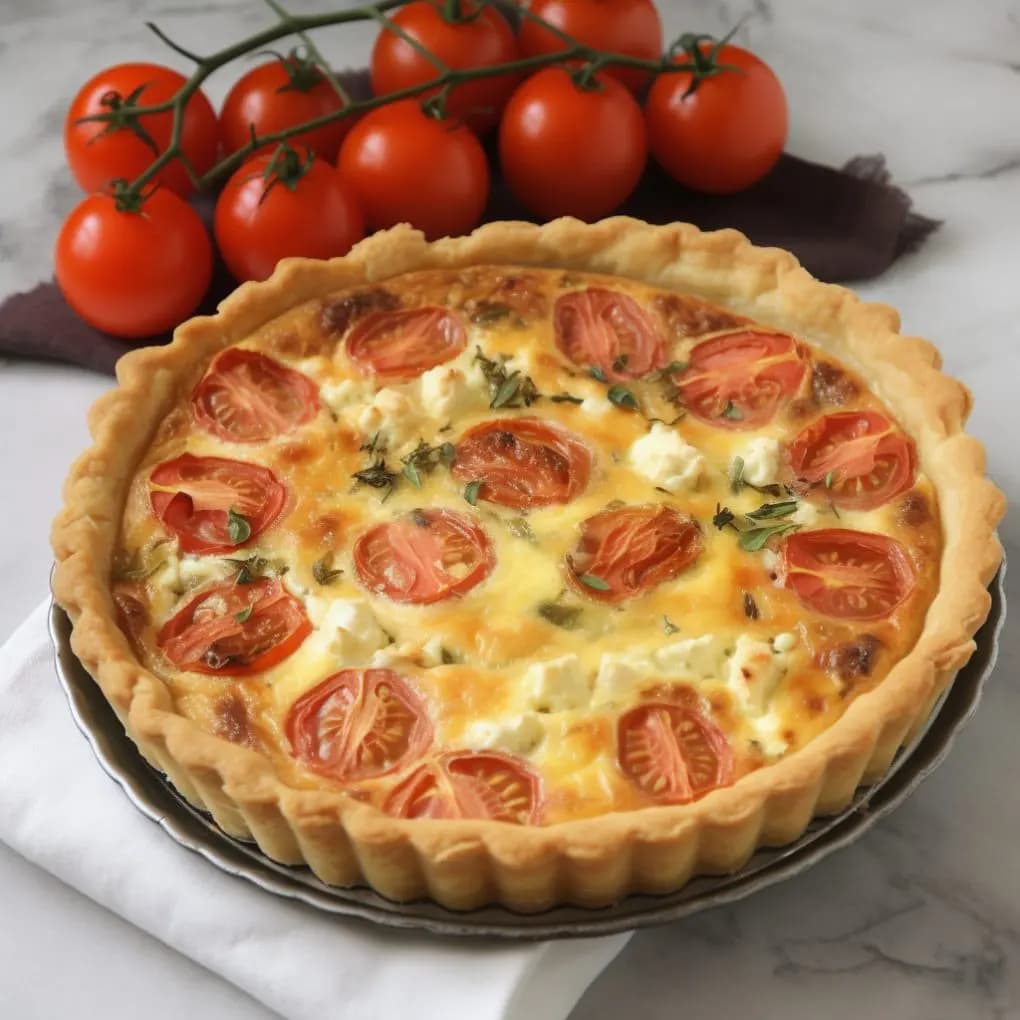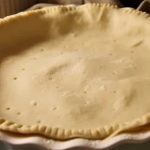If you’ve ever admired the perfect crispness of a pastry base in a tart or pie, you’ve likely encountered the magic of shortcrust pastry. The Mary Berry Shortcrust Pastry is a timeless classic, known for its buttery flavor and tender texture. This recipe is straightforward and takes about 40 minutes from start to finish, making it a go-to for both beginners and seasoned bakers alike.
What is Mary Berry Shortcrust Pastry?
Shortcrust pastry is a versatile dough, ideal for both sweet and savory dishes. The Mary Berry version is particularly popular for its simplicity and perfect results every time. This pastry forms the foundation of many delicious recipes, offering a crisp texture that beautifully complements a variety of fillings.

Other Popular Recipes
Why You Should Try This Recipe
- Reliable Results: Mary Berry’s recipe ensures consistent and perfect pastry every time.
- Simple Ingredients: Only a few pantry staples are needed to create this delightful dough.
- Versatile Use: Suitable for pies, tarts, quiches, and more.
- Beginner-Friendly: The steps are straightforward, making it an ideal recipe for novices.
- Quick Preparation: The pastry comes together in just about 15 minutes.
- Perfect for Freezing: You can prepare it in advance and freeze it for later use.
Ingredients Needed to Make Mary Berry Shortcrust Pastry
- 225g (8oz) plain flour
- 100g (4oz) cold butter, diced
- 2-3 tablespoons cold water
- A pinch of salt
Equipment
- Mixing bowl
- Pastry cutter or knife
- Rolling pin
- Cling film
- Tart tin or pie dish
Instructions to Make Mary Berry Shortcrust Pastry
To make Mary Berry Shortcrust Pastry, follow these simple steps:
Step 1: Combine Flour and Butter
- In a large mixing bowl, add 225g (8oz) of plain flour and a pinch of salt.
- Cut 100g (4oz) of cold butter into small cubes and add them to the flour.
- Using your fingertips, gently rub the butter into the flour until the mixture resembles fine breadcrumbs. Be careful not to overwork the mixture, as the butter should stay cold.
Step 2: Add Water Gradually
- Sprinkle in 2-3 tablespoons of cold water, one tablespoon at a time.
- Mix the water into the flour and butter mixture using a knife, gently stirring until the dough begins to come together.
- If the dough is still too crumbly, add a little more water, but avoid making it too wet.
Step 3: Form the Dough
- Once the dough starts to form, use your hands to gently gather it into a ball.
- If the dough feels too dry, add a bit more water, but be cautious not to overwork it.
Step 4: Chill the Dough
- Wrap the dough ball in cling film, ensuring it’s tightly sealed.
- Place the wrapped dough in the refrigerator and let it chill for at least 20 minutes. This step helps to relax the gluten, making the dough easier to roll out and less likely to shrink during baking.
Step 5: Roll Out the Pastry
- After chilling, remove the dough from the fridge and unwrap it.
- Lightly flour your work surface and rolling pin.
- Roll out the dough to your desired thickness, usually around 3mm (1/8 inch) for most recipes. Turn the dough occasionally to prevent it from sticking to the surface.
Step 6: Line the Tin
- Carefully lift the rolled-out pastry and drape it over your tart tin or pie dish.
- Gently press the dough into the edges and sides of the tin, making sure it fits snugly without stretching the pastry.
- Trim off any excess dough from the edges using a sharp knife.
Step 7: Blind Bake if Required
- If your recipe calls for a pre-baked crust, line the pastry with baking paper and fill it with baking beans or uncooked rice. This process, known as blind baking, helps to keep the pastry from puffing up.
- Preheat your oven to 200°C (400°F).
- Bake the pastry in the preheated oven for 15 minutes.
- After 15 minutes, remove the baking paper and beans, and return the pastry to the oven for an additional 5 minutes to ensure it is fully baked and golden brown.

What Goes Well With Mary Berry Shortcrust Pastry
- Lemon Meringue Pie: The crisp pastry contrasts beautifully with the tangy lemon filling.
- Quiche Lorraine: A savory classic that pairs perfectly with shortcrust pastry.
- Apple Tart: The buttery base complements the sweet, spiced apples.
- Chocolate Ganache Tart: Rich chocolate filling meets the flaky pastry for a decadent treat.
- Vegetable Tart: A healthy, colorful dish that’s perfect for any meal.
- Minced Pies: A festive favorite with a crumbly, delicious pastry.
Expert Tips for Making the Best Mary Berry Shortcrust Pastry
- Use Cold Butter: Ensure the butter is chilled to prevent it from melting into the flour too quickly.
- Don’t Overwork the Dough: Mix the ingredients just enough to combine them; overworking can make the pastry tough.
- Chill Before Rolling: Chilling the dough helps relax the gluten, making it easier to roll and less likely to shrink during baking.
- Roll Evenly: Try to maintain an even thickness when rolling out the dough to ensure uniform baking.
- Use Minimal Water: Adding too much water can make the dough sticky and hard to handle.
- Prevent Soggy Bottoms: If your recipe includes a wet filling, consider blind baking the pastry first.
Easy Variations of Mary Berry Shortcrust Pastry
- Sweet Shortcrust Pastry: Add 2 tablespoons of sugar to the flour for a sweet version.
- Wholemeal Shortcrust Pastry: Substitute half of the plain flour with wholemeal flour for a nuttier flavor.
- Cheese Shortcrust Pastry: Mix in 50g (2oz) of grated cheddar for a savory twist.
- Herb-Infused Pastry: Add chopped fresh herbs like thyme or rosemary to the dough for extra flavor.
- Nutty Shortcrust Pastry: Substitute 50g (2oz) of the flour with ground almonds or hazelnuts for added texture.
Best Practices to Store Mary Berry Shortcrust Pastry
- Refrigerate for Short-Term Use: Wrap in cling film and store in the fridge for up to 3 days.
- Freeze for Longer Storage: Place the dough in a freezer bag, label it, and freeze for up to 3 months.
- Thaw Properly: Always thaw frozen dough in the fridge overnight before using.
- Pre-Baked Storage: Store pre-baked pastry shells in an airtight container at room temperature for up to 3 days.
- Keep Unused Portions: Roll out any extra dough, cut into shapes, and freeze for later use.
Best Practices to Reheat Mary Berry Shortcrust Pastry
- Reheat in Oven: Warm the pastry in a preheated oven at 180°C (350°F) for 5-10 minutes.
- Avoid Microwave: Reheating in a microwave can make the pastry soggy.
- Use a Baking Sheet: Place the pastry on a baking sheet to maintain its crispness.
- Cover with Foil: If reheating a filled pastry, cover the edges with foil to prevent them from over-browning.
- Room Temperature Option: Allow the pastry to come to room temperature for 15-20 minutes before serving.
How Can I Make Mary Berry Shortcrust Pastry Healthier?
- Use Wholemeal Flour: Substituting some of the plain flour with wholemeal adds fiber.
- Reduce Butter: You can reduce the amount of butter slightly for a lower fat content.
- Use Olive Oil: Swap some of the butter with olive oil for a healthier fat option.
- Add Seeds: Incorporate flax or chia seeds into the dough for extra nutrients.
- Sugar-Free: For sweet variations, use a sugar substitute or eliminate sugar altogether.
How do I Chill Shortcrust Pastry
Chilling the pastry dough is a crucial step in ensuring it’s easy to handle and bakes perfectly.
Here’s how to do it:
- Wrap the Dough: Once you have formed the dough into a ball, wrap it tightly in cling film. Make sure there are no air pockets, as exposure to air can dry out the dough.
- Refrigerate: Place the wrapped dough in the refrigerator and let it chill for at least 20 minutes. This resting period allows the gluten in the dough to relax, which will prevent the pastry from shrinking when it’s baked.
- Timing: If you’re planning ahead, you can chill the dough for several hours or even overnight. The longer chilling time can enhance the texture and flavor of the pastry.
How to Use Shortcrust Pastry
Shortcrust pastry is incredibly versatile and can be used for a variety of dishes.
Here’s how to use it:
- Preparation: Remove the chilled dough from the fridge and let it sit at room temperature for about 5-10 minutes. This makes it easier to roll out without cracking.
- Rolling Out: On a lightly floured surface, roll out the dough to fit the size and shape of your pie dish or tart pan.
- Filling: Once lined with the rolled-out pastry, you can fill it with your choice of sweet or savory fillings.
- Baking: Bake according to your recipe’s instructions. For pies and tarts that require a pre-baked shell, use the blind baking method described earlier.
Shortcrust Pastry for Sweet Dishes
Shortcrust pastry is a favorite for many sweet dishes. Here’s how to tailor it for desserts:
- Sweetening the Dough: For sweet dishes, you can add a tablespoon or two of sugar to the dough mixture to give it a subtle sweetness.
-
Examples of Sweet Uses:
- Fruit Tarts: Fill the pastry with cream or custard and top with fresh fruits.
- Lemon Tart: Use the pastry as a shell for a rich lemon curd filling.
- Pecan Pie: The buttery crust pairs wonderfully with the gooey, sweet filling of a classic pecan pie.

Shortcrust Pastry for Savoury Dishes
Shortcrust pastry also works wonderfully for savory recipes.
Here’s how to adapt it:
- Adjusting the Flavor: You can add spices such as paprika or herbs like thyme to the dough to complement your filling.
-
Examples of Savory Uses:
- Quiche: A classic quiche with a savory custard filling of eggs, cream, cheese, and other ingredients like spinach or bacon.
- Meat Pies: Use the pastry to encase rich fillings like minced meat, vegetables, and gravy.
- Vegetable Tart: Fill the crust with a mixture of seasonal vegetables and cheese for a delicious and hearty dish.
Nutrition Value (per serving):
- Calories: 180 kcal
- Carbohydrates: 20g
- Protein: 3g
- Fat: 10g
- Saturated Fat: 6g
- Fiber: 1g
- Sodium: 150mg
FAQs
Can I Make Shortcrust Pastry Ahead of Time?
Yes, you can make shortcrust pastry ahead of time. Wrap the dough tightly in cling film and store it in the refrigerator for up to 3 days. For longer storage, freeze the dough for up to 3 months and thaw it overnight in the refrigerator before use. This makes it convenient for preparing dishes that require a pastry base without the last-minute hassle.
How Do I Prevent My Shortcrust Pastry From Shrinking?
To prevent shortcrust pastry from shrinking, ensure you chill the dough for at least 20 minutes before rolling and lining your tin. Additionally, avoid overworking the dough when mixing and rolling, as this can activate the gluten and cause the pastry to shrink during baking. Blind baking with baking beans or rice can also help maintain the shape of your pastry.
What Is the Best Thickness for Rolling Out Shortcrust Pastry?
The ideal thickness for rolling out shortcrust pastry is about 3mm (1/8 inch). This thickness provides a sturdy base for fillings while ensuring the pastry cooks through without becoming too hard or brittle. It’s thick enough to support the weight of both sweet and savory fillings but thin enough to deliver a delicate, crisp texture.
Can Shortcrust Pastry Be Used for Both Sweet and Savory Pies?
Shortcrust pastry is incredibly versatile and suitable for both sweet and savory pies. Its neutral flavor makes it an excellent base for a variety of fillings, from fruit tarts to meat pies. For sweet pies, consider adding a small amount of sugar to the dough. For savory dishes, you can incorporate herbs or spices to complement the filling.
What Does Adding an Egg to Shortcrust Pastry Do?
Adding an egg to shortcrust pastry enhances its texture and color. The egg acts as a binding agent, helping the dough hold together better, which makes it easier to roll and shape. Eggs also contribute to a richer flavor and create a more golden, appealing color when baked.
Do You Use Plain or Self-Raising Flour for Shortcrust Pastry?
For shortcrust pastry, you should use plain flour rather than self-raising flour. Plain flour gives you control over the amount of rising agent in the pastry, ensuring it remains flat and crisp rather than puffy, which is crucial for both the texture and structural integrity of pies and tarts.
Should You Blind Bake Shortcrust Pastry for a Pie?
Blind baking shortcrust pastry is recommended for pies with wet fillings or where the filling cooks faster than the crust. This technique involves pre-baking the pastry shell with weights like baking beans to prevent the dough from rising or puffing up. Blind baking ensures that the base is fully cooked and crisp, preventing a soggy bottom.
Is Margarine or Butter Better for Shortcrust Pastry?
Butter is generally preferred for shortcrust pastry due to its flavor and the ability to create a flakier texture. Margarine can be used as a substitute, especially for those looking for a dairy-free option, but it may result in a slightly different texture and taste. Butter’s fat content helps form better layers in the pastry, making it crisper and richer.
What Is the Secret of Good Shortcrust Pastry?
The secret to good shortcrust pastry lies in keeping the ingredients, especially the butter, cold throughout the mixing and rolling process. This prevents the fat from melting before baking, which is crucial for achieving a flaky, tender texture. Additionally, handling the dough as little as possible to avoid developing the gluten is key, as this will help maintain a crisp, delicate structure.
Final Words
Mary Berry’s Shortcrust Pastry is an essential recipe for any home baker’s collection. Celebrated for its simplicity and flexibility, it consistently delivers delightful results. This pastry seamlessly complements both savory quiches and sweet tarts, providing a flawless foundation for your culinary creations.
More By British Baking Recipes
Print
Mary Berry Shortcrust Pastry Recipe
- Prep Time: 15
- Cook Time: 20
- Total Time: 35 minutes
- Yield: 6 1x
- Category: Side Dish
- Method: Baking
- Cuisine: British
Description
Shortcrust pastry is a versatile dough, ideal for both sweet and savory dishes. The Mary Berry version is particularly popular for its simplicity and perfect results every time. This pastry forms the foundation of many delicious recipes, offering a crisp texture that beautifully complements a variety of fillings.
Ingredients
- 225g (8oz) plain flour
- 100g (4oz) cold butter, diced
- 2–3 tablespoons cold water
- A pinch of salt
Instructions
Step 1: Combine Flour and Butter
- In a large mixing bowl, add 225g (8oz) of plain flour and a pinch of salt.
- Cut 100g (4oz) of cold butter into small cubes and add them to the flour.
- Using your fingertips, gently rub the butter into the flour until the mixture resembles fine breadcrumbs. Be careful not to overwork the mixture, as the butter should stay cold.
Step 2: Add Water Gradually
- Sprinkle in 2-3 tablespoons of cold water, one tablespoon at a time.
- Mix the water into the flour and butter mixture using a knife, gently stirring until the dough begins to come together.
- If the dough is still too crumbly, add a little more water, but avoid making it too wet.
Step 3: Form the Dough
- Once the dough starts to form, use your hands to gently gather it into a ball.
- If the dough feels too dry, add a bit more water, but be cautious not to overwork it.
Step 4: Chill the Dough
- Wrap the dough ball in cling film, ensuring it’s tightly sealed.
- Place the wrapped dough in the refrigerator and let it chill for at least 20 minutes. This step helps to relax the gluten, making the dough easier to roll out and less likely to shrink during baking.
Step 5: Roll Out the Pastry
- After chilling, remove the dough from the fridge and unwrap it.
- Lightly flour your work surface and rolling pin.
- Roll out the dough to your desired thickness, usually around 3mm (1/8 inch) for most recipes. Turn the dough occasionally to prevent it from sticking to the surface.
Step 6: Line the Tin
- Carefully lift the rolled-out pastry and drape it over your tart tin or pie dish.
- Gently press the dough into the edges and sides of the tin, making sure it fits snugly without stretching the pastry.
- Trim off any excess dough from the edges using a sharp knife.
Step 7: Blind Bake if Required
- If your recipe calls for a pre-baked crust, line the pastry with baking paper and fill it with baking beans or uncooked rice. This process, known as blind baking, helps to keep the pastry from puffing up.
- Preheat your oven to 200°C (400°F).
- Bake the pastry in the preheated oven for 15 minutes.
- After 15 minutes, remove the baking paper and beans, and return the pastry to the oven for an additional 5 minutes to ensure it is fully baked and golden brown.



